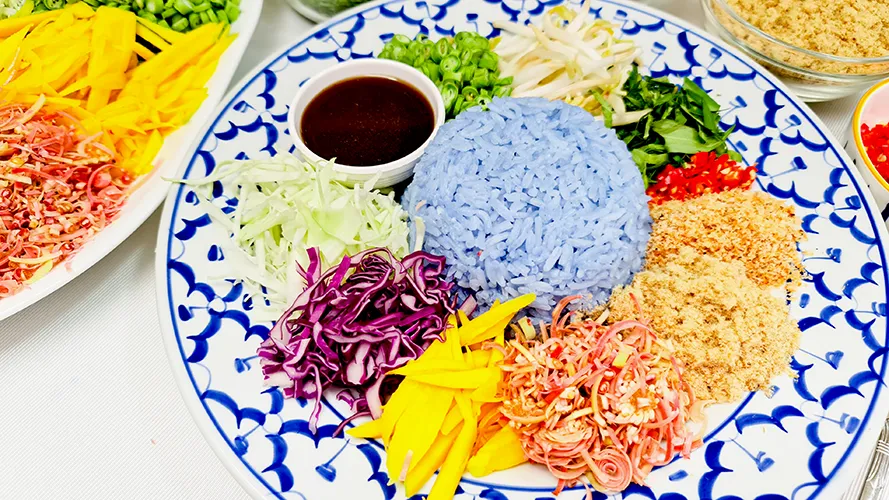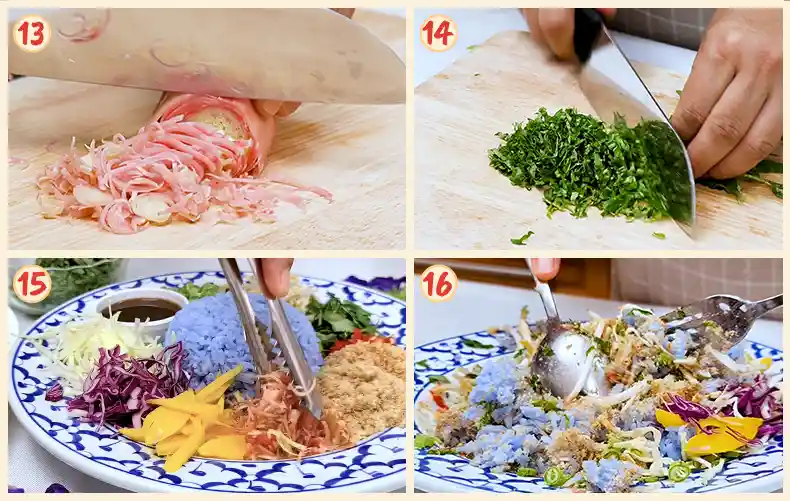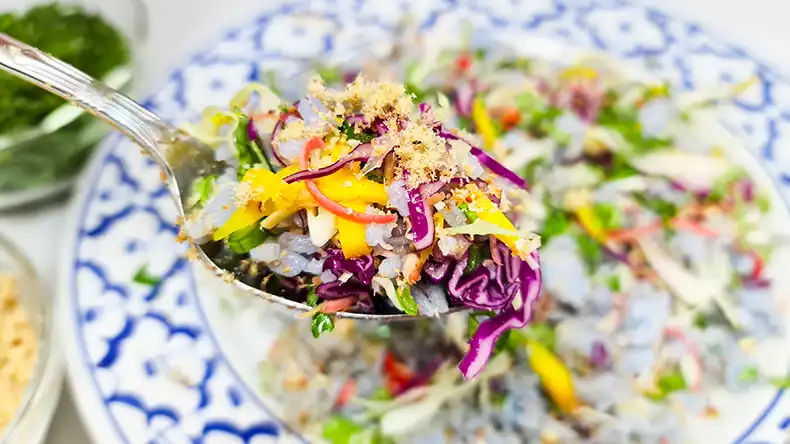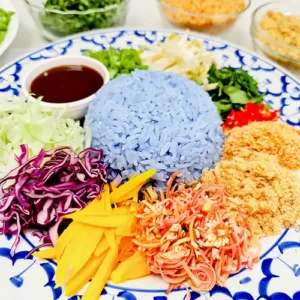Khao Yum – Rainbow Rice Salad

Khao Yum, which is also known as “Thai Rainbow Rice“, is a type of “salad” that is so colourful and fragrant. The signature brilliant blue colour of the dish first catches the eyes, followed by the many condiments around the dinner plate. It is known as a “salad” dish because a majority of those condiments are raw vegetables. Thus, it is also highly nutritious, full of fibre and capable of cleansing the body thoroughly after a meal.
Khao Yum is eaten as a breakfast meal so often in Southern Thailand, you can find local vendors selling it alongside the streets. It is a dish that is fragrantly aromatic, umami, salty and with a light tinge of sourness.
It is quite similar to “Nasi Kerabu” in Malaysia, where it is also an “ulam” (raw vegetables) dish. However, there are subtle differences that I have observed – Nasi Kerabu is usually served with fried fish crackers and whole fried fish, while Khao Yum uses fish floss. Also, Khao Yum has a sour ingredient incorporated, while Nasi Kerabu has “sambal belacan” instead.

Although so commonly prepared by the local people, it does take some effort in preparing Khao Yum as there is a lot of chopping, slicing and dishing out to do. As such, I consider it more of a “party food”, than an everyday meal, sizing up the recipe for 8 to 10 servings. If preferred, you can also prepare a similar amount, and take your time enjoying throughout the days. Do take a look at how to store them, so they remain fresh.
This recipe serves 8 to 10 people.
Ingredients

Budu sauce, which is known as “Budu Nam Khao Yum”. It is salty and full of umami, fragrant with the aroma of anchovy sauce, similar to fish sauce. It is a specially fermented anchovy sauce meant to be served with Khao Yum. Many people in Thailand will make their own sauce, but for this recipe, I used a bottled one. It is available in Thailand, and can also be bought online in Malaysia.
Toasted Coconut, which is roughly grounded. They add a lovely, smokey flavour and fragrance to the dish. While I bought them, it is possible to make them from scratch. The preparation method is similar to making “kerisik” – just stopping at the pounding step.
Fish floss, which is commonly sold in Thailand. It adds an umami flavour to the Khao Yum dish while being easy to mix with the other ingredients. It is one of the ingredients that are unique to Khao Yum, as Nasi Kerabu tends to use crispy fish crackers and fried fish as protein.

Butterfly pea flower, which is added as a natural colouring to the rice. It imparts no flavour nor fragrance – only the colour. This is why it is recommended not to wash them beforehand, as contact with water does reduce the amount of colour that can be extracted. For your peace of mind, try obtaining the organic type. There is also no difference in the colour extraction process between the fresh and dried types.
Thai Jasmine rice adds a lovely fragrance to the Khao Yum dish. Immediately once cooked, gently stir them. This fluffs them up, separating each grain from the other.
Salt, to add to the rice, to taste.
Hot water, to extract the natural colouring of the butterfly pea flower, and normal temperature water, which is the balance added to cook the rice.
And the raw vegetables that are crunchy and naturally sweet. The following vegetables are what I used in this Khao Yum dish.

Long beans, with both ends of the tips removed and sliced thinly.
Green mango, which is peeled and cut into strips, as though preparing them for Thai Mango Salad. The cutting technique is also used in making Som Tam (Green Papaya Salad). Although my green mango turned out to be already yellow, it was still quite firm, sour and ever-so-slightly sweet, which fits perfectly in my Khao Yum dish. If green, unripe mangoes are not available, peeled sour pomelo that is separated into smaller pieces, or cut lime that is squeezed onto the dish works as well. Just to note, this sour element is usually not included in the Nasi Kerabu dish.
White cabbage, shredded thinly and cut into 3 or 4 sections, perpendicular to the strips.
Purple/ red cabbage, which is not a common ingredient in Khao Yum. However, I added it in anyway for a lovely contrast of colour.
Red bird’s eye chilli, for that signature Thai spicy kick in a Thai dish. Use a little at a time, taking into account your and your guest(s) spicy tolerance level. However, I highly recommend including it as the capsaicin adds an addictive spiciness to every bite of the Khao Yum. If fresh chilli is unavailable, chilli flakes work as well.
Torch Ginger Flower, which is a mandatory herbal flower in the Khao Yum. It is known as “Dok Dahla” in Thai and “Bunga Kantan” in Bahasa Malaysia. It gives a special fragrance, and a fresh and herbal sensation when enjoying this dish.
Vietnamese basil, which is also known as “Daun Kesom”. The green leaves are plucked from the stem while discarding the tough stems and yellow leaves. Slicing them finely, they add another herbal fragrance to the dish.
Raw bean sprouts – for additional crunchiness and appearance. While most people would pluck the roots first to give them a better appearance, it is not necessary, as leaving them on or removing them does not affect the taste.

While the following ingredients were not added, they can be used as a substitute if one or more of the raw vegetables are not available. However, do note that the taste of the Khao Yum may vary slightly according to the vegetables used:
Four angled beans, sliced thinly.
Raw carrots, julienned and cut into bite-sized strips.
Cucumber, julienned and cut into bite-sized strips.
Raw lettuce, cut into bite-sized pieces.
White radish, julienned and cut into bite-sized pieces.
Lastly, as an option for added protein, one hard-boiled egg. While I did not include it in my recipe, most Khao Yum dishes in Thailand are served with one or a half of a hard-boiled egg.
Steps
Here are the brief steps to make Khao Yum:

- Prepare the ingredients.
- Soak butterfly pea flower in hot water.
- Wash the rice.
- Remove the flowers from the water.

- Add flower water, salt and enough water to cook the rice.
- Cook the rice.
- Slice long beans thinly.
- Peel and chop mango into strips.

- Slice white cabbage.
- Slice purple cabbage.
- Stir the rice gently once cooked.
- Chop red chillies.

- Slice torch ginger flowers.
- Pluck and chop Vietnamese Basil leaves.
- Assemble the Khao Yum.
- Mix all the ingredients together.
Tips
- The most important ingredients of the Khao Yum are the Budu sauce for Khao Yum (or Nasi Kerabu), fish floss, toasted ground coconuts, a sour ingredient (unripened mango, sour pomelo or some cut limes to squeeze the juice), and torch ginger flower.
- While the butterfly pea flower is necessary for the Khao Yum’s signature brilliant blue colour, when eating in private, it is ok to omit it if it is unavailable, as it does not impart any fragrance or taste to the rice.
- For the reason above, a little salt is added to make the rice a little more tastier.
- When plucked fresh, it is not recommended to wash the flowers as that might cause a good amount of the colouring to be removed. Instead, steep it in hot water, and strain the water while adding it to the rice.
- Use Thai Jasmine rice for added fluffiness and a wonderful fragrance to the blue rice.
- As the vegetables are eaten raw and are added for both the colourful appearance and crunchiness, the more fibrous vegetables should be sliced very thinly. These include long beans, cabbages, and torch ginger flowers.
- I recommend wearing food-grade gloves when handling the red bird’s eyes chilli, to prevent staining your hands with capsaicin, with can irritate the hands and the other areas that it touches.
- Be sure to cut the raw, fibrous vegetables into bite-sized pieces too, so they fit the spoon and mix easily with the rest of the ingredients.
- The main difference between Khao Yum and Nasi Kerabu is, Khao Yum is often served with fish floss and a sour ingredient, while Nasi Kerabu is served with crunchy fish crackers, fried fish or chicken, and a spicy sambal belacan.
- Make sure to watch the full video to see how I made it exactly!

Storage Instructions
As the majority of Khao Yum are vegetables, it is best to keep them sealed in an air-tight container, or in cling wrap, in the fridge once cut. They can be kept in this manner for about 1-2 days, as long as they are dry.
As for the rice, once cooled, it can be kept in the fridge, in an air-tight container for up to 2 days. They can also be kept frozen for a few weeks at a time. Be sure to reheat by steaming for about 10-15 minutes (once thawed if frozen) over boiling water before serving.
The Budu sauce will keep in the fridge for a very long time, provided there is no moisture. I would recommend storing the fish floss and toasted coconut in individual air-tight bags in the freezer, taking only the desired portions to enjoy when necessary.
However, once all the ingredients have been mixed in a plate of Khao Yum, it is recommended to consume it immediately. Storing or keeping is not recommended as once mixed, all the ingredients will deteriorate at a faster rate.

Recipes You Might Like
- Simple & Delicious Thai Mango Salad – Yum Ma Muang
- Authentic Som Tam – Thai Green Papaya Salad Recipe (Isaarn-Soul Food)
- Delicious Homemade Authentic Pad Thai Recipe (ผัดไทย)
- Authentic Thai Mango Sticky Rice Recipe


Khao Yum (Thai Rainbow Rice Salad)
Equipment
- Rice Cooker
- Small Heatproof bowl
- Sharp Kitchen Knife
- Chopping Board
- Fruit Peeler
- Food Tongs
- Food-grade Gloves
- Stainless basin
Ingredients
Cooking Rice
- 30 g butterfly pea flowers, organic & fresh
- 250 ml hot water, just boiled
- 3 cups Thai Jasmine rice, washed, with the water drained
- 300 ml water, to add on to the hot water, to make it sufficient to cook the rice.
- 1/2 tsp salt, to taste
Vegetable as Condiments
- 7 strands long beans, raw
- 1 mango, unripened, slightly sour
- 150 g white cabbage, shredded thinly
- 100 g purple cabbage, shredded thinly
- 12 red bird's eye chilli
- 2 torch ginger flower
- 30 g Vietnamese Basil, leaves plucked and stems discarded
Assembling a plate of Khao Yum
- 1 tbsp toasted coconut
- 2 tbsp fish floss
- 1/2 tsp bird's eye chilli, finely chopped
- 1/2 tbsp Vietnamese Basil, finely chopped
- 15 g beansprouts, raw
- 1 tbsp long beans, chopped
- 1 tbsp budu sauce, served in a little saucer
- 15 g white cabbage, finely shredded
- 15 g purple cabbage, finely shredded
- 15 g mango, thin strips
- 15 g torch ginger flower, finely shredded
- 1 hard boiled egg, optional
Instructions
- Prepare the ingredients.
- Add the butterfly pea flowers into a heat-resistant bowl. Pour hot water and submerge the flowers and give a gentle stir. Set it aside for 10 minutes.
- Add the rice to the detachable rice pot, or basin. Add water to the rice while gently agitating them. Drain the water. Fill the rice pot with water once and drain it again. If using a basin, transfer the rice into the rice pot. Set it aside.
- After 10 minutes, stir the flowers in the hot water, gently pressing them to extract more natural colouring. Remove the flowers from the bowl and discard them.
- Pour the flower water into the rice pot, over a strainer to remove any debris, and add additional water until there is sufficient to cook the rice. Cover the lid and cook the rice.
- Meanwhile, prepare the vegetables. Remove the tips of the long beans on both ends, and cut them into three sections. Align the ends on one side and slice them thinly. When done, set the aside.
- Next, peel the mango with a peeler. Then, with one hand holding up the mango and the other holding the knife, carefully chop the mango, while rotating it. When the incisions have been made all around the mango, guide the knife with the index finger, and carefully slice the strips off the mango. Repeat until you are left with the seed. Discard the seed and set the mango strips aside.
- Slice the white cabbage into thin strips, as though making shredded cabbage. Then, cut the strips into 3 parts to make them shorter. Set them aside. Repeat with the purple cabbage.
- Check on the rice. Once it is cooked, open the cover and gently stir the top to fluff up the rice. Cover the pot and set it to keep warm.
- Then, remove the stalks from the chillies. Chop them finely and set them aside.
- Slice the torch ginger flowers thinly, stopping at the part of the stem that is fibrous. Discard the stems. Then, cut the flower strips into 3 to make them shorter. Set them aside.
- Lastly, pluck the Vietnamese basil leaves from their stems. Discard both the stems and yellow leaves. Roll the leaves and slice them thinly. Set them aside.
- To assemble the Khao Yum, stir the blue rice a little. Gently pack the fluffy rice into a small bowl. Then place it upside down onto the dinner plate, tapping the bowl a few times to release the rice. Add each of the ingredients around the plate, according to the measurements, increasing or decreasing the amount according to preferences. For the Budu sauce, serve about 1 tbsp in a small saucer. Serve with all of the prepared vegetables and condiments. Optionally, serve with a hard-boiled egg per serving.
- To eat, pour about half of the Budu sauce all over the rice and vegetables. If serving with an egg, cut it up into pieces with a spoon. Then, mix them until well combined, or until they resemble a colourful salad, and enjoy. Add more Budu sauce or any other condiment, according to taste.
Video
Notes
- The most important ingredients of the Khao Yum are the Budu sauce for Khao Yum (or Nasi Kerabu), fish floss, toasted ground coconuts, a sour ingredient (unripened mango, sour pomelo or some cut limes to squeeze the juice), and torch ginger flower.
- While the butterfly pea flower is necessary for the Khao Yum’s signature brilliant blue colour, when eating in private, it is ok to omit it if it is unavailable, as it does not impart any fragrance or taste to the rice.
- For the reason above, a little salt is added to make the rice a little more tastier.
When plucked fresh, it is not recommended to wash the flowers as that might cause a good amount of the colouring to be removed. Instead, steep it in hot water, and strain the water while adding it to the rice. - Use Thai Jasmine rice for added fluffiness and a wonderful fragrance to the blue rice.
- As the vegetables are eaten raw and are added for both the colourful appearance and crunchiness, the more fibrous vegetables should be sliced very thinly. These include long beans, cabbages, and torch ginger flower.
- Be sure to cut the raw, fibrous vegetables into bite-sized pieces too, so they fit the spoon and mix easily with the rest of the ingredients.
- I recommend wearing food-grade gloves when handling the red bird’s eyes chilli, to prevent staining your hands with capsaicin, with can irritate the hands and the other areas that it touches.
- The main difference between Khao Yum and Nasi Kerabu is, Khao Yum is often served with fish floss and a sour ingredient, while Nasi Kerabu is served with crunchy fish crackers, fried fish or chicken, and a spicy sambal belacan.
- Note: the nutritional values includes the plate of rice and 1 hard-boiled egg.
- Make sure to watch the video to see exactly how I made it!